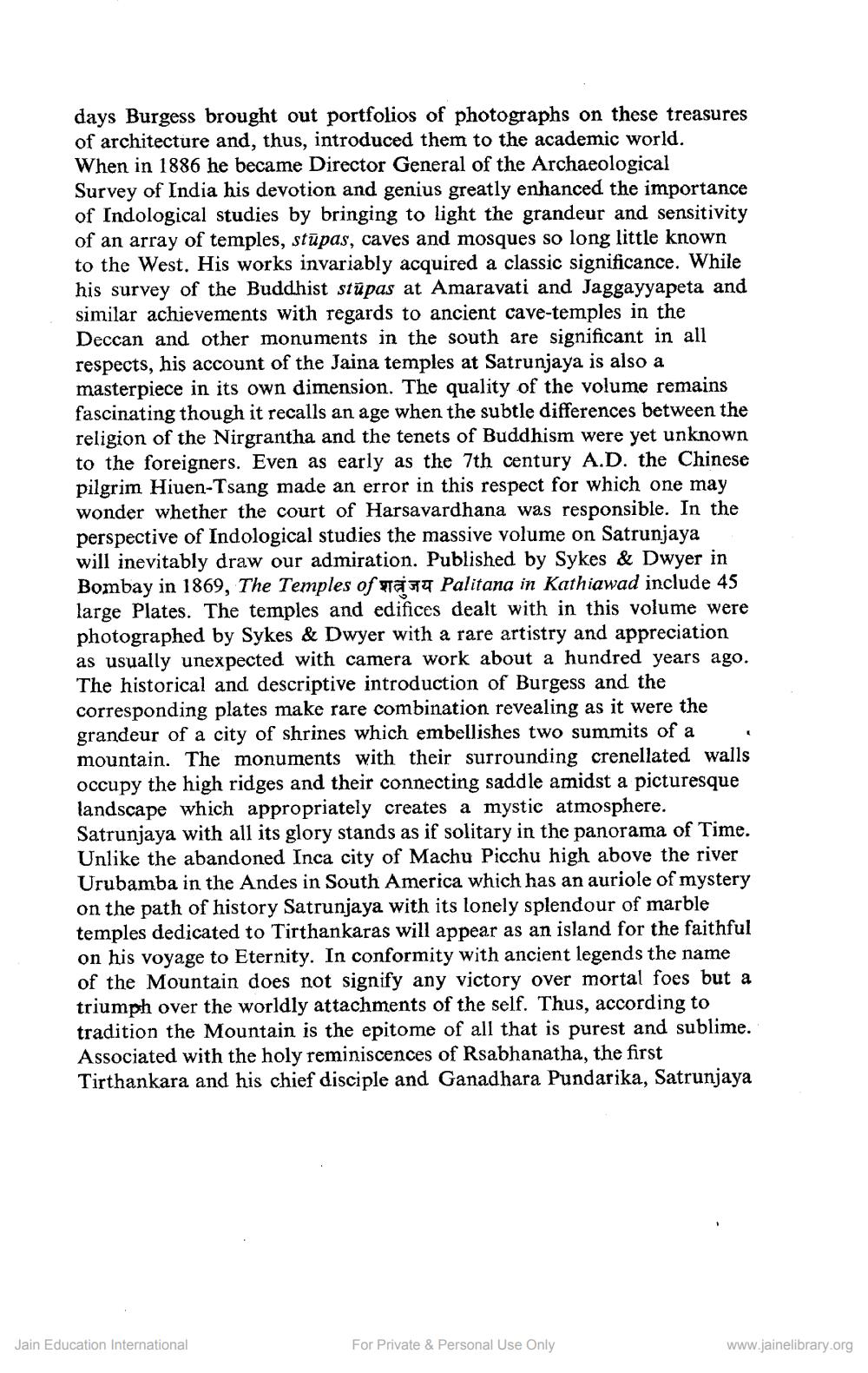Book Title: Temple of Satrunjaya Author(s): Jain Bhawan Publication Publisher: Jain Bhawan Publication View full book textPage 9
________________ days Burgess brought out portfolios of photographs on these treasures of architecture and, thus, introduced them to the academic world. When in 1886 he became Director General of the Archaeological Survey of India his devotion and genius greatly enhanced the importance of Indological studies by bringing to light the grandeur and sensitivity of an array of temples, stūpas, caves and mosques so long little known to the West. His works invariably acquired a classic significance. While his survey of the Buddhist stupas at Amaravati and Jaggayyapeta and similar achievements with regards to ancient cave-temples in the Deccan and other monuments in the south are significant in all respects, his account of the Jaina temples at Satrunjaya is also a masterpiece in its own dimension. The quality of the volume remains fascinating though it recalls an age when the subtle differences between the religion of the Nirgrantha and the tenets of Buddhism were yet unknown to the foreigners. Even as early as the 7th century A.D. the Chinese pilgrim Hiuen-Tsang made an error in this respect for which one may wonder whether the court of Harsavardhana was responsible. In the perspective of Indological studies the massive volume on Satrunjaya will inevitably draw our admiration. Published by Sykes & Dwyer in Bombay in 1869, The Temples of Palitana in Kathiawad include 45 large Plates. The temples and edifices dealt with in this volume were photographed by Sykes & Dwyer with a rare artistry and appreciation as usually unexpected with camera work about a hundred years ago. The historical and descriptive introduction of Burgess and the corresponding plates make rare combination revealing as it were the grandeur of a city of shrines which embellishes two summits of a mountain. The monuments with their surrounding crenellated walls occupy the high ridges and their connecting saddle amidst a picturesque landscape which appropriately creates a mystic atmosphere. Satrunjaya with all its glory stands as if solitary in the panorama of Time. Unlike the abandoned Inca city of Machu Picchu high above the river Urubamba in the Andes in South America which has an auriole of mystery on the path of history Satrunjaya with its lonely splendour of marble temples dedicated to Tirthankaras will appear as an island for the faithful on his voyage to Eternity. In conformity with ancient legends the name of the Mountain does not signify any victory over mortal foes but a triumph over the worldly attachments of the self. Thus, according to tradition the Mountain is the epitome of all that is purest and sublime. Associated with the holy reminiscences of Rsabhanatha, the first Tirthankara and his chief disciple and Ganadhara Pundarika, Satrunjaya Jain Education International For Private & Personal Use Only www.jainelibrary.orgPage Navigation
1 ... 7 8 9 10 11 12 13 14 15 16 17 18 19 20 21 22 23 24 25 26 27 28 29 30 31 32 33 34 35 36 37 38 39 40 41 42 43 44 45 46 47 48 49 50 51 52 53 54 55 56 57 58 59 60 61 62 63 64 65 66 67 68 69 70 71 72 73 74 75 76 77 78 79 80 81 82 83 84 85 86 87 88 89 90 91 92 ... 122
